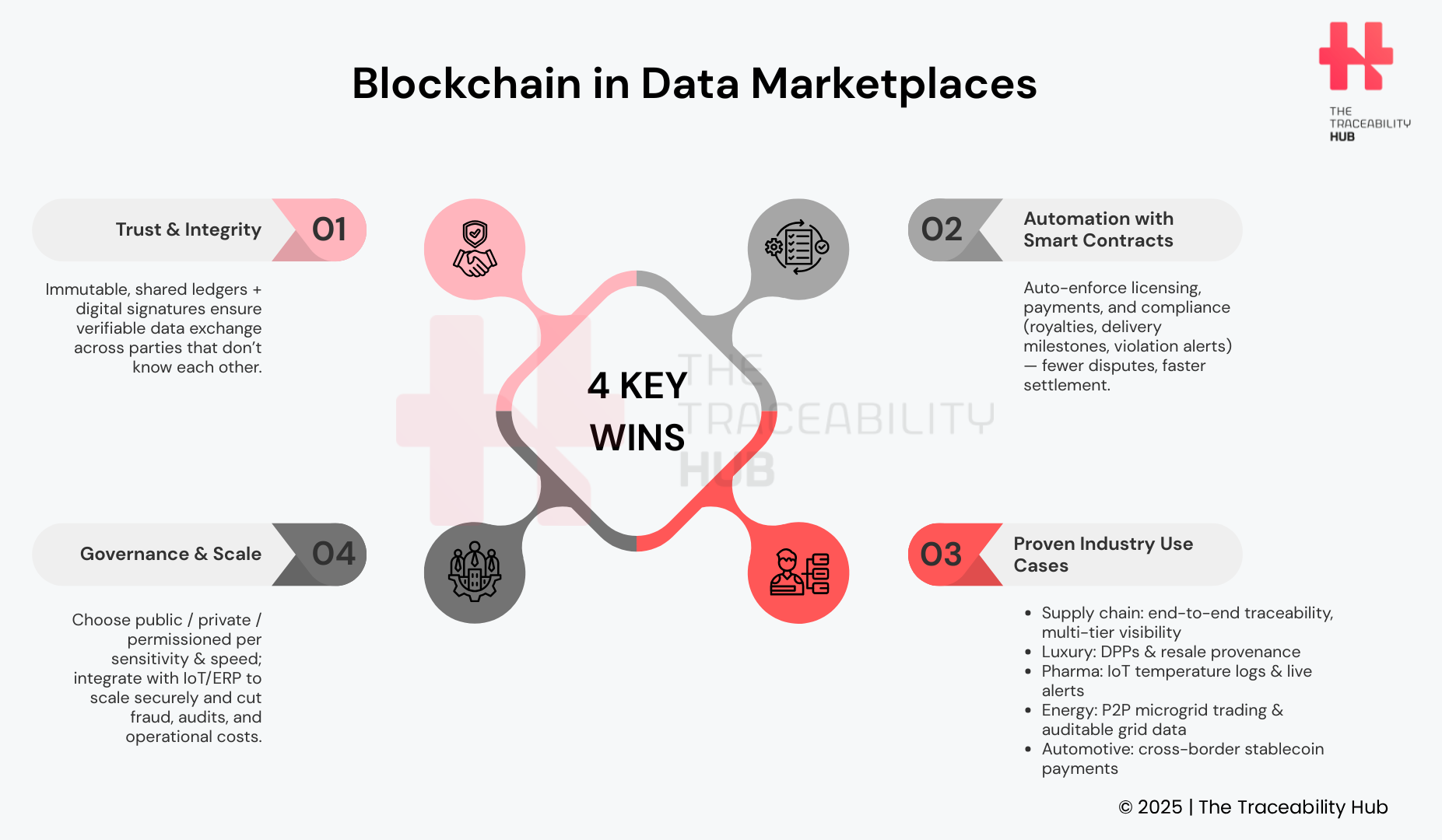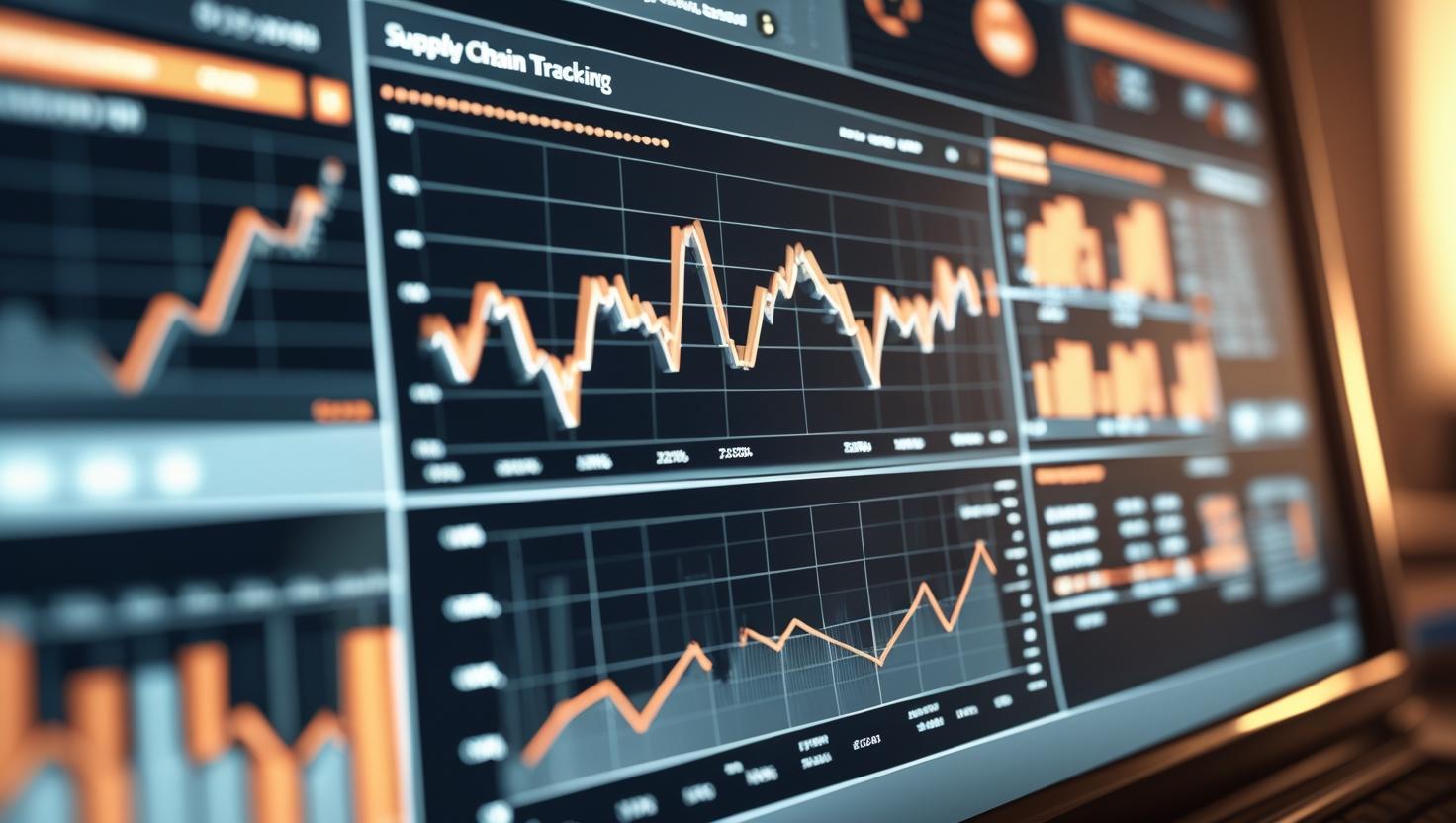Blockchain Applications in Data Marketplaces: Real Business Value Beyond Cryptocurrency
Blockchain technology applications now go way beyond cryptocurrency and show their real-life value in industries of all sizes. The technology behind blockchain has moved past the hype, and businesses now implement solid solutions that tackle real-life challenges in data exchange and data marketplace operations.
Supply chain management (SCM) stands out as one of the most promising areas where blockchain makes a difference. Technology creates a new level of transparency and trust between parties who used to depend on disconnected systems. Blockchain solutions help with product authentication, temperature-controlled logistics, and automated contract execution.
Major players like Walmart, DHL, and energy companies have already moved from testing to full deployment.
This piece looks at proven blockchain applications that bring measurable business value to data marketplaces.
We focus on systems that have moved beyond initial testing phases.
Organizations use distributed ledger technology (DLT) to solve concrete business problems from luxury goods authentication to pharmaceutical cold chains.
These solutions create new opportunities for secure data exchange.
Why Blockchain Technology Matters for Data Marketplaces
Data marketplaces struggle to build trust between participants who don’t know each other. Blockchain technology solves this biggest problem by creating secure, transparent systems for data exchange. A digital database forms blockchain’s foundation, where transaction records spread across multiple computers instead of a central location.
Blockchain in Data Marketplaces

Distributed Ledger Architecture for Data Exchange
Blockchain works on distributed ledger technology (DLT), where network participants share and sync copies of the ledger.
This approach is different from traditional centralized data systems.
Each participant keeps a similar copy of the ledger, which means everyone can access the same data and check its authenticity without depending on central authority.
Blockchain’s security comes from cryptographic hashes and consensus mechanisms. Data transactions get grouped into “blocks” and link to previous transactions through cryptographic hashes that create an unbreakable chain of information. Once recorded on the blockchain, data can’t be changed or deleted, which creates a permanent and verifiable record of all transactions, essentially an Immutable Record.
Blockchain applications also guard data against unauthorized access through public-key cryptography and digital signatures. Everyone can see the public key, while the owner’s private key stays secret.
This cryptographic foundation means data owners retain control even in shared marketplace environments.
Smart Contracts: Automating Trust and Transactions
Smart contracts stand out as blockchain’s most powerful application in data marketplaces. These self-executing agreements live directly on the blockchain and automatically enforce preset rules for data sharing. To name just one example, a smart contract for licensing digital content can automatically pay the data owner whenever someone uses their information.
Smart contracts work on their own once deployed, unlike traditional agreements that need middlemen. They execute transactions automatically when conditions are met, which cuts down on administrative work and potential disputes.
This automation helps with intellectual property licensing, where calculating and distributing royalties can be complex and time-consuming.
Data marketplace smart contracts enable:
- Automated license enforcement without intermediaries
- Up-to-the-minute royalty calculations and payments
- Transparent recording of data usage
- Unbreakable verification of ownership and licensing terms
Smart contracts can’t change after deployment, which makes them reliable tools for building trust between marketplace participants.
Public vs Private Blockchain for Marketplace Governance
Data marketplace’s governance structure depends heavily on the blockchain type. Three main models exist, each with unique features that shape how data exchanges work:
- Public blockchains welcome anyone to join and take part in core network activities freely. They offer decentralized data access, democratic operations without central control. These open systems can raise security concerns for sensitive data transactions. Bitcoin and Ethereum are well-known public blockchain networks.
- Private blockchains limit participation through careful authorization. The owner’s right to change, edit, or remove entries makes them ideal for enterprise applications where data privacy matters most. Private blockchains might not be fully decentralized, but they work as distributed ledgers protected by cryptographic concepts and organizational security measures.
- Permissioned blockchains blend public and private model features. Anyone can join after identity checks, but they get specific permissions for network activities. Businesses often prefer this hybrid approach, especially for Blockchain-as-a-Service (BaaS) solutions that grow with organizational needs.
Organizations must think about data sensitivity, compliance requirements, processing speed needs, and control priorities when choosing a blockchain type for data marketplaces. Private or permissioned blockchains usually handle confidential data, large datasets, and real-time processing better than public options.
Product Provenance in Luxury Goods Marketplaces
The luxury goods industry faces a major problem with counterfeits. The global counterfeit market now tops USD 3.00 trillion each year. Over the last several years, blockchain technology has become a powerful way to curb this issue and create unprecedented supply chain transparency in product authentication and ownership tracking.
Luxury Goods and Counterfeit Prevention with Blockchain
Blockchain in Luxury Goods: Digital Certificates for Authenticity Verification
Luxury brands now turn to blockchain in luxury goods-based digital certificates to prove their products are genuine. These certificates act as tamper-proof digital identities permanently recorded on distributed ledgers.
The Aura Blockchain Consortium, 2021 old and created by industry giants LVMH and Richemont (later joined by OTB group and Mercedes-Benz), leads the charge in adopting “Digital Product Passports” (DPPs) across the luxury sector.
Each luxury product gets a unique blockchain-based identifier, usually embedded through an NFC chip or QR code. Customers scan this code to see their product’s complete history: from its manufacturing origin through its supply chain experience. Blockchain in luxury goods verification process beats traditional authentication methods in several ways:
- Immutable verification: Blockchain records cannot be altered or duplicated
- Complete transparency: Shows manufacturing details, material sources, and supply chain information
- Instant authentication: No more waiting for expert verification
Dior shows this approach with its USD 1500.00 B33 sneaker release. Buyers trace each pair’s production journey through blockchain in luxury goods verification. De Beers uses blockchain to certify diamond provenance from mining through mounting. This addresses ethical sourcing concerns that matter to today’s luxury consumers.
Blockchain-Backed Ownership History for Resale Platforms
Blockchain technology changes the luxury resale market by tracking ownership securely.
Secondary markets and marketplaces for high-value items often lack transparency. Blockchain in luxury goods provide critical verification for previously owned luxury goods.
Technology creates an unalterable timeline of ownership transfers throughout a product’s life. Buyers on resale platforms see the complete ownership history of luxury items they want to buy. This solves two big problems in luxury resale.
It removes counterfeit risks by proving provenance from original manufacturers through each owner. Technology makes ownership transfers simple without paper documentation. A product’s blockchain certificate transfers with the sale, which removes the need for traditional receipts while keeping verification intact.
Blockchain creates a “closed loop” for luxury brands.
Companies like Vaultik combine ownership certificates with on-chain insurance protection for luxury items. Brands get new revenue streams while staying connected to products after resale.
London-based NIX Time, which customizes luxury watches, uses blockchain to authenticate original serial numbers and modification details.
This is a big deal as it means that resale values increase. Items with blockchain in luxury goods verification sell for more because buyers know they’re authentic and can see their maintenance history.
This system helps everyone:
- brands protect their reputation
- sellers prove item legitimacy
- buyers feel confident without middlemen.
Blockchain technology turns luxury goods marketplaces from shadowy spaces into clear ecosystems. Authenticity and ownership become facts you can verify rather than matters of trust.
Pharmaceuticals and Cold Chain Monitoring Through Blockchain
Temperature-sensitive pharmaceuticals create unique supply chain challenges. Vaccines and specialty medications need exact environmental conditions during storage and transport. The pharmaceutical industry loses about USD 35.00 billion each year because of temperature problems during shipping. One in four vaccines arrives damaged at its destination due to wrong shipping conditions.
Blockchain Integration with IoT for Temperature Logs
The cold chain faces ongoing challenges. These include split monitoring systems, manual audits, and data that people can tamper with.
Blockchain in pharmaceuticals supply chains show how distributed ledgers create permanent records of key temperature data.
IoT sensors on pharmaceutical shipments keep track of important environmental factors:
- Temperature (key for vaccines that need 2-8°C range)
- Humidity levels
- Light exposure
- Physical handling (drops or impacts)
- Location tracking
These sensors create live data streams that flow right into blockchain networks.
Blockchain integration with IoT works through special hardware, often using Raspberry Pi minicomputers to link sensors with blockchain networks. Each reading gets a crypto signature and stays on the distributed ledger forever. This creates a permanent temperature history for every pharmaceutical shipment.
This setup shows blockchain’s power in supply chain management. It creates what cold chain experts call a “single source of truth”. Temperature data on the blockchain can’t change later. This matters in the following of rules and checking product safety: an unchangeable record that lets stakeholders see a product’s full environmental history from maker to patient.
Coldnet shows how this works in practice. This blockchain-based vaccine tracking system combines IoT proof with permanent data recording. It offers complete monitoring and stays scalable. Tests showed Coldnet’s transaction costs hit USD 1.51 to track ten vaccine batches with five properties each. This cost makes sense given the extra security.
Blockchain in Pharmaceuticals: Smart Contracts for Live Violation Alerts
Smart contracts are the foundations of pharmaceutical cold chain monitoring systems. These self-running programs enforce preset compliance rules without human help. They turn regulatory requirements into code that checks incoming sensor data against set limits.
For vaccine shipments, a smart contract might say:
“Temperature must stay between 2°C and 8°C during transport”.
Blockchain in cold chain monitoring create automatic enforcement:
- Immediate violation detection: The contract triggers right away if temperatures go outside limits
- Automated stakeholder notifications: Alerts go straight to manufacturers, distributors, and recipients
- Status change enforcement: Products get marked “non-saleable” if compromised
- Payment process integration: Money transfers stop for shipments with proven violations
Smart contracts record temperature problems on the blockchain right away.
This creates timestamped proof of exactly when and where violations happened. The contract can then send automatic alerts to key people, stop distribution, or pause payments until someone checks the situation.
Blockchain integration with IoT application gives pharmaceutical companies clear visibility into their cold chains. Before blockchain, temperature data sat in separate places. This made finding bad products sort of hard-to-get one’s arms around. Now, standard data from temperature loggers across supply chains enables live monitoring. Teams can act fast when environmental readings go outside acceptable ranges.
Blockchain in pharmaceuticals supply chain creates a system where consumers can check if their medications stayed at the right temperature during distribution. This final check step creates a fully transparent cold chain.
It makes sure medications work properly from production to use.
Blockchain in Supply Chain Data Sharing
Supply chain management stands out as one of the most promising areas for blockchain adoption. Ground implementations already deliver business value. Procurement leaders don’t deal very well with transparency challenges that blockchain technology addresses through decentralized, tamper-proof transaction systems.
Immutable Records for Supplier Audits
Traditional supplier auditing takes time and remains vulnerable to data manipulation. Blockchain technology creates an unchangeable audit trail that revolutionizes this process. The distributed ledger permanently records each transaction, making retroactive changes impossible to hide.
This immutability offers several key advantages for supplier audits:
- Tamper-proof verification – Data on the blockchain stays permanent and unchangeable, ensuring complete audit trail integrity
- Immediate visibility – Auditors see a transparent and unchangeable record of all transactions, which makes the audit process simpler
- Reduced fraud risk – Permanent blockchain records make supplier fraud nearly impossible because network participants spot every attempted change
Manufacturing companies find this unchangeable ledger valuable to verify supplier origins for regulations or trace parts when problems arise.
Blockchain makes it easier to audit supplier credentials, certifications, and compliance history through verified digital identities.
Amazon Managed Blockchain shows this approach by creating a pipeline that collects IoT device data and stores it on a private blockchain. Only authorized organizations can access it. This solution creates an unchangeable source of truth for future audits and helps learn about supply chain transactions with less effort.
Multi-Tier Visibility Beyond Tier-1 Vendors
Limited visibility into extended supply networks remains one of the biggest problems in modern procurement. A global survey of 500+ procurement professionals shows 65% have limited or no visibility beyond their Tier-1 suppliers. This lack of transparency creates risks for companies that unknowingly support exploitative labor conditions, deforestation, or other harmful practices.
Blockchain technology solves this fundamental problem by enabling transparent, verifiable tracking throughout complex multi-tier supply chains.
Early supply chain blockchains focused on immediate suppliers, but current systems extend visibility much deeper:
- Tokenization for complete tracking lets physical goods become digital tokens on a blockchain. Each product or shipment gets a unique token that helps stakeholders track its movement across every supply chain stage. This creates unprecedented transparency in complex global networks.
- Walmart proves blockchain’s value for multi-tier visibility through two notable examples. Their food blockchain solution cut mango origin tracing time from seven days to 2.2 seconds. On top of that, it successfully tested a solution to track pork shipments in China. The system tracked products from processing through shipping, customs, and final delivery with complete food transparency.
Blockchain creates value for supply chain data sharing through:
- End-to-end traceability – Blockchain records create an unchangeable audit trail of product origins, production, quality checks, and ownership transfers
- Smart contract automation – Self-executing contracts with preset rules make shared procurement activities easier, including purchase orders, delivery checks, and payments
- Improved supplier relationships – Shared data and transparent processes promote trust and collaboration throughout the supply network
Organizations should understand that widespread adoption needs collaborative effort and standard agreements.
Despite challenges from different company needs, blockchain’s benefits in supply chain management – including less fraud, better compliance, and streamlined processes – make it worth pursuing.
Energy Data Marketplaces and Microgrid Trading
Blockchain adoption has transformed the energy sector. This decentralized technology changes how we trade and monitor electricity.
Microgrids with blockchain capabilities create new ways to trade peer-to-peer (P2P), automate transactions, and comply with regulations.
Blockchain in the Energy Sector: From Microgrids to Prosumers
Peer-to-Peer Energy Exchange via Ethereum Smart Contracts
Microgrid systems have brought a game-changing concept called “prosumers”: consumers who also produce their own electricity through renewable sources.
This transformation from traditional one-way energy supply creates local energy markets where people can sell extra power directly to their neighbors.
Ethereum smart contracts provide the technical foundation for these peer-to-peer (P2P) energy trading systems. These smart contracts programs confirm, record, and settle energy transactions live across distributed energy resources.
The system works through:
- Smart meters that record energy generation and consumption
- Digital tokens (often ERC-20 standard) representing energy credits
- Automated matching algorithms balancing supply and demand
- Secure transaction validation through blockchain consensus
Users can set up smart contract rules without technical knowledge.
The system then executes transactions automatically when conditions match, which removes middlemen that typically increase costs and time.
The Brooklyn microgrid project showed how blockchain suits decentralized energy markets by meeting all but one of these essential components for an efficient grid. MG is a community-driven initiative that began in the Park Slope and Gowanus communities, Spring of 2016. A Benefit Corporation established by LO3 Energy, the project reimagines the traditional energy grid model, with the concept of a communal energy network.
Power Ledger in Australia has built connected communities or “microgrids” that work as layers on top of national power infrastructure. These examples show how blockchain technology gives control back to individual users instead of centralized utilities.
Live Grid Data Logging for Regulatory Compliance
Blockchain technology helps solve transparency issues in energy markets by creating permanent records of key operational data.
The Chilean National Energy Commission (CNE) built an Ethereum-based platform to track energy data reliably. This prevents data manipulation and reporting mistakes that used to cause big financial losses.
The blockchain-based system records energy data such as:
- Market prices and fluctuations
- Marginal production costs
- Compliance with energy regulations
- Fuel price variations
Blockchain platforms connect with smart meters and IoT sensors to create secure records of energy production and consumption.
These systems can log temperature changes, voltage levels, and peak usage times automatically, giving regulators access to records that cannot be changed.
Blockchain-based compliance systems stand out because anyone can verify transactions. Stakeholders can check records directly, which makes the energy ecosystem more transparent. This helps meet strict regulatory requirements and reduces compliance costs.
Energy data marketplaces show how blockchain technology goes beyond financial transactions to build reliable infrastructures for essential utilities.
Blockchain’s permanent records give utilities and consumers more confidence in data integrity as regulatory frameworks grow: a must-have for working energy markets.
Automated Payments in Automotive Supply Chains
Automotive manufacturing has one of the most complex supply chains in the world. Thousands of parts come from suppliers of all sizes spread throughout many countries. Regular payment systems often hit roadblocks with international settlements. This creates bottlenecks that affect production schedules and relationships with suppliers.
Blockchain technology offers trailblazing solutions to these old problems.
Bitcoin and Stablecoin Transactions for Cross-Border Settlements
The global nature of the automotive industry needs quick ways to handle international payments. Regular international transfers take one to five business days because multiple middlemen work in different time zones and process payments in batches. Stablecoin payments happen almost right away, with much lower fees and they work all year round.
Stablecoins, digital currencies pegged to stable assets like the US dollar, have become valuable tools for automotive supply chains.
Here’s what makes them great:
- Cost efficiency: They cost less than old-school money transfer services
- 24/7 operations: You can make payments whatever the banking hours or holidays
- Settlement speed: Money moves in minutes instead of days
- Transparency: You can track every dollar from start to finish
Car makers with factories in multiple countries see big benefits beyond just making payments. Financial leaders are looking at how these digital assets can make treasury operations better. The money backing stablecoins gets invested in things like Treasury bills, which earn more than traditional payment methods.
Yet adoption varies by region, with some areas showing better results than others. Companies in automotive e-commerce, payroll, and merchant services are leading the way with implementation.
Smart Contract Enforcement of Delivery Milestones
Smart contracts are another game-changing blockchain tool reshaping automotive supply chains. These self-running agreements automatically enforce set conditions without human input. They turn contract terms into computer code that runs by itself when conditions are met.
In automotive supply chains, smart contracts follow a simple but powerful rule: “If the delivery checks out, pay the vendor”.
Once it’s set up, nobody can change this rule unless everyone agrees.
This creates several benefits:
- Payments happen automatically when milestones are met, which cuts down payment cycles that used to take weeks.
- The system also creates permanent, time-stamped records that meet regulatory requirements.
- Money gets released automatically when shipments hit specific points:
- Original pickup from supplier facility
- Customs clearance completion
- Final delivery to the manufacturing plant
This automation cuts down payment disputes between manufacturers and parts suppliers by creating data both sides can trust. It also protects buyers and sellers by holding funds safely until contract terms are met.
Fixed-price deals with clear milestones and work best in automotive supply chains because you can easily verify the results. Smart contracts also help track parts from lower-tier suppliers, which reduces the risk of counterfeits: a crucial issue in car manufacturing.
Automotive companies still face some hurdles implementing blockchain, as old systems often need updates or replacement to work with new technology.
Still, the benefits of transparency, efficiency, and fewer disputes make blockchain an attractive option for car manufacturers who want to improve their supply chain operations.
Blockchain for Food Traceability and Safety
Food safety problems affect billions worldwide: nearly one in ten people get sick from contaminated food each year. These issues lead to roughly half a million deaths annually. Product tracing remains difficult in traditional food supply chains from source to consumer. Blockchain for food traceability serves as a game-changer by creating permanent, tamper-proof records at every step of the food’s experience.
Food Traceability: Farm-to-Fork Authenticity with Blockchain
End-to-End Tracking from Farm to Fork
The food industry’s supply chain connects many participants. Small-scale farmers, processors, distributors and retailers all play vital roles. This complex network creates challenges to establish complete visibility. Blockchain for food traceability solves these problems by creating digital records that track food products from production to consumption.
Blockchain for food traceability systems capture essential information throughout the farm-to-fork process:
- Origin details and harvest dates
- Farming practices and input usage (pesticides/fertilizers)
- Processing methods and environmental conditions
- Transportation routes and storage temperatures
- Quality control procedures and compliance verification
Consumers can scan QR codes on products to access this complete information instantly. They can verify everything from ingredient sources to transportation conditions.
This transparency helps build consumer trust and lets businesses spot potential safety issues early.
Blockchain’s unchangeable data proves extremely valuable for food traceability and food safety. Information stored on the blockchain stays permanent and unalterable. This creates reliable records that all stakeholders trust. Companies can now identify contamination sources almost instantly during outbreaks, replacing the old time-consuming process.
Many companies now use blockchain for food traceability.
TE-FOOD tracks over 400,000 transactions daily across 6,000 businesses.
These real-life examples show how blockchain creates real value by improving food supply chain visibility.
Blockchain for Food Traceability: Walmart’s Pork Traceability System in China
Walmart’s pork traceability project in China is one of the blockchain supply chain first example. The retail giant partnered with IBM and Tsinghua University back in 2016. Together they developed a blockchain system to track pork products throughout China’s supply chain.
China’s serious food safety concerns prompted this system’s development. The government had seized 100,000 tons of smuggled meat in 2015, with some dating back decades. Walmart’s blockchain for food traceability solution recorded complete information about products. This included farm origins, factory data, expiration dates, storage temperatures, and shipping details.
The same happen to trace a package of mangoes. The process lasted nearly seven days – 6 days, 18 hours, and 26 minutes to be exact. While the same trace took just 2.2 seconds with blockchain technology.
This pork traceability system improved greatly on previous methods that used only barcodes and RFID tags.
Their blockchain system gave every supply chain member – producers, processors, distributors, and retailers – more visibility into product movements.
After that proof of concept, Blockchain-based food traceability systems continued growing beyond their original implementations.
These systems still benefit producers, retailers, and consumers alike. They demonstrate practical blockchain applications that deliver measurable business value while making food safer for everyone.
Blockchain in Logistics: Smarter Tracking with IoT and Smart Pallets
Supply chains face visibility gaps that create monitoring challenges, especially with environmental conditions. Smart contracts combined with IoT sensors create powerful blockchain applications that solve these issues.
DHL Smart Pallets with Blockchain-Linked Sensors
DHL has become a game-changer in blockchain implementation by launching its own blockchain solution for logistics tracking. The company’s smart pallet system demonstrates this technology’s practical application. It monitors location and environmental conditions such as temperature, humidity, and physical shocks during transport continuously. These advanced pallets combine multiple tracking technologies: QR codes, NFC tags, IoT sensors, GPS trackers and Bluetooth beacons to create detailed monitoring capabilities.
DHL’s blockchain network receives this data directly and creates an immutable record of shipping conditions. Everyone in the supply chain, from warehouse managers to end customers, can access this information.
Trigger-Based Alerts for Environmental Deviations
Smart contracts act as self-executing programs that enforce predefined rules automatically when sensor data triggers them. These contracts monitor each logistics process step against rules defined in the code. The system generates alerts to stakeholders automatically when environmental measurements fall outside acceptable ranges.
Smart contracts do more than send notifications: they verify compliance with regulations and standards, release payments when conditions are met, and provide cryptographic evidence of rule adherence. This system ended up creating a trusted business ecosystem with fewer intermediaries.
Future Outlook: Blockchain as the Backbone of Data Marketplaces
Blockchain technology has moved beyond theoretical concepts and cryptocurrency applications to deliver real business value in industries of all sizes. Looking at ground implementations, patterns show how blockchain proves useful in practice.
The distributed ledger architecture transforms how organizations build trust, especially when you have unfamiliar parties in data marketplace environments.
Smart contracts stand out as the most important advancement. These self-executing agreements automate complex processes that once needed human oversight. From pharmaceutical temperature monitoring to automated supplier payments, they reduce administrative work and speed up transactions reliably.
Without doubt, pioneers like Walmart have provided the vision for future applications. Their food traceability time dropped to seconds, showing how blockchain improves efficiency. Luxury brands now curb counterfeiting through tamper-proof digital certificates. Energy companies make peer-to-peer electricity trading easier with decentralized platforms.
Successful blockchain projects share key traits. They solve specific business problems instead of using technology just because it’s new. They merge with existing systems and IoT devices. They create value for everyone in the ecosystem. Cold chain monitoring systems protect medicine quality and simplify compliance rules. Supply chain tools boost visibility beyond direct suppliers while cutting audit costs and fraud risks.
Blockchain adoption is one technology to improve product transparency, immutability. It works best in processes with multiple parties who don’t fully trust each other, need complex documentation, or require verification.
Examples in this piece show how distributed ledger technology has grown from a speculative investment into a practical solution. Organizations that carefully implement blockchain traceability applications gain competitive edges through improved efficiency, stronger data integrity, and unmatched supply chain visibility.
Read more: Real Results: Blockchain Technology in Lombardy’s Bread Supply Chain






